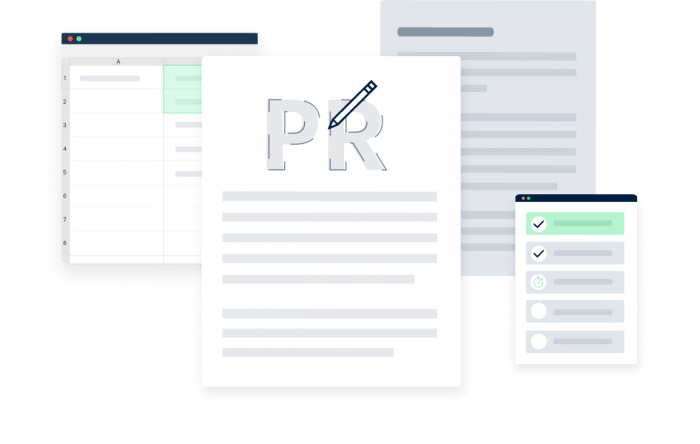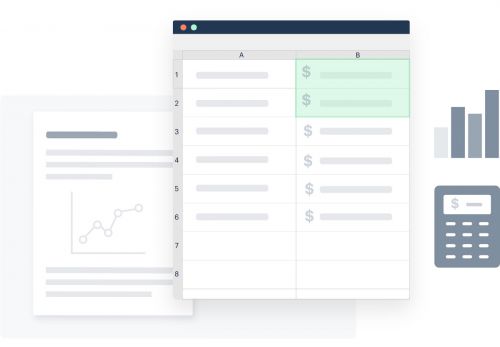The ultimate guide to PR strategy and planning
A simplified guide to making strategic decisions and keeping your activities organized

Introduction: Do you really need a strategy?
Yes. PR is a full-time job, and the day-to-day tasks are so time-consuming that teams often start missing the big picture, and instead end up focusing on tasks that might not have an impact on their core objectives. Public relations strategic planning should have a positive impact on your brand, and the best way to ensure this is to have a strategy in place, and a plan to execute it.
Your PR plan and strategy will help you navigate and prioritize every day’s demand. With established goals, you can follow the best tactics to create an impact. While every brand is different, we’ll go through the fundamental parts you need to be able to develop a strategy and plan around it using our PR tools and strategies.
Creating a PR plan that works
Take the PR strategy and planning guide with you. |

1
Assess the situation
Whether you call it an analysis or an assessment, this is the foundation of any future decisions you make. This is where PR teams and public relations strategic planning can – and should – be working with other stakeholders like Marketing, Product, Commercial, and Customer Support to get a complete overview of the business situation, and the markets or environments thin at you’re operating in. Your financial situation, business goals, corporate image, product plans, and competitors are just some examples of information you should have in your situation analysis that will inform your PR strategy and goals.
Also, keep an eye on the big picture. Consider these questions when doing public relations strategic planning:
- What does your industry look like today?
- Have there been any significant changes in the last few years?
- What might change in the coming period?
- Which economic and political conditions might affect your industry?

2
Identify your audiences
Sending your message out to the world at large is not an effective approach. Identifying who you’re talking to – and gaining an understanding of them – is the crucial foundation of effective PR. Taking the time to research and connect with your audience using PR Tools and Strategies will help you develop your entire approach, adding a focus and intent to your strategy that will speak clearly through your end results.
Your public relations strategic planning should keep in mind two groups of audiences – your buyers, and people who can influence your buyers.
Your main target audience
When developing your strategy, keep your customers front-of-mind as your main target audience. Take the time to get to know them; the customers themselves will provide the most important information for setting your PR strategy:
- Find out who your buyers are and why they pay for your product/s or use your services.
- Define and craft the story that speaks to their needs.
- Research where and how they consume media.
Those who can influence your main target audience
This group can include journalists, bloggers, influencers, and editors of publications in your industry. Industry experts and thought leaders with a large number of blog subscribers or social media followers, also belong to this group. Tools like BuzzSumo can help you find influential writers.
If you’re a Presspage user, you could also do further research by getting access to a database with around 900 thousand media contacts, including journalists, bloggers and influencers.
 Tip
Tip
Do background research on where your competitors are mentioned to help you identify publications to reach out to.
You can reach your first group of audiences much better by developing better relationships with the second. You should also have an easy process set up for this group to get relevant and valuable information from you, such as establishing an SEO-optimized newsroom to make it easier for journalists in your industry to find your content.

3
Set up PR goals and objectives
Public relations strategic planning goals and objectives are sometimes used interchangeably, leading to plenty of confusion. In this guide, we’ll discuss the G.O.S.T model – Goals, Objectives, Strategies, and Tactics.
Goals
What you want to accomplish overall.
Ex.: [Your brand] wants to become the best-known brand for [your product/sector] in the US.
Objectives
The specific outcomes from your public relations strategic planning should define how you achieve the goal. These should be SMART (specific, measurable, agreed upon, realistic and time-based).
Ex. Increase the number of new visitors to the website by 20% in 2020.
Strategies
The approach you take to achieving measurable objectives.
Ex. Implement an ambassador program.
Tactics
PR Tools and Strategies you use to support the tactics that you’ve decided on.
Ex. Reach out to 50 US-based influencers and bloggers with personalized pitches.
Companies have taken different approaches to applying the G.O.S.T model in PR teams. The first is by having “Goals” as the overall business or company goals, with PR objectives or strategies coming in below to support the goal.
Business Goal
We want our company to be the number 1 selling brand in this industry
Business Objective
Increase sales by 15% this year
Pr Strategies To Support Business Objective
Increase traffic to our e-commerce website by collaborating with influencers and have them promote our product
The second is by setting up a complete G.O.S.T model within the PR/communications team that’s based on overall company goals or objectives.

Setting up a model like G.O.S.T is a crucial step to give your team direction when juggling multiple tasks. It might be difficult to see the impact of one press release after another, but having concrete numbers will give you a clear objective to strive for. With every public relations strategic planning activity, you can set goals such as increasing website traffic, blog subscriptions and share of voice on social media. Digital tools are crucial in helping you measure impact.

4
Develop key messages
Key messages are the essence of what you want to communicate with your customers and will be the building blocks for all your tactics and activities developed through the help of your PR tools and strategies.
Think of key messages as the anchor that keeps all your communication unified and consistent, and what will inform all the messaging on your other PR channels. Here are the three things to consider when crafting key messages:
- Revisit your company’s mission and core values.
- Pick words and phrases in your brand vocabulary, avoid anything too generic or too similar to your competitors’ key messages.
- Consider the assessment of your situation to address changes in the industry and any new identity that your brand wants to adopt.
Your key messages should be concise, simple, and adaptable.
Concise: Lengthy messages are difficult to remember and adapt.
Simple: It should be easy to understand for most people. No jargon or acronyms.
Memorable: In this world of information overloading, easy-to-recall messages stand out.
Adaptable: for being used in different channels and various forms. Avoid using wordplay that only sounds smart, for example, in writing but not when speaking.
Compelling: You want your audiences to take action.
Evocative: The best messages are the ones that evoke strong feelings and the desire to be a part of something bigger than themselves.
Let’s go over a quick example of a key message and its supporting messages.
“Our company’s products deliver tangible ROI”
While this is the core message we want to communicate, we wouldn’t use this particular wording in our external communication. Instead, we would create PR tools and strategies where we can drive secondary messages forward that support this key message. Supporting messages would look something like this:
“Our customers on average report an increase in revenue of 29% after 6 months of using our product”
Your PR team could complete public relations strategic planning out of these supporting messages, for example in writing articles about specific customers that have benefited from the product. Further proof points like hard-hitting quotes can be used to strengthen the message. Example:
“Since we started using this product, referral traffic from the newsroom to our e-commerce website has increased by over 180%”.

5
Identify PR channels
Now it’s time to decide on how you’re going to deliver your messages to your target audiences. There are various PR tools and strategies that PR pros can use to approach their customers. It’s important to recognize that you don’t have to do it all, especially if your team is fairly small. Identify channels where your target audiences spend their time, and what tactics will get you the most value. Common PR channels that should be included in your public relations strategic planning are:
- A central newsroom or media center
- Press releases
- Blogs
- Social media
- Events
Newsroom
Whether you call it a newsroom, media center, or press page, the premise is the same; a communications hub that connects the organization with its audiences. Newsrooms tend to be at the core of a PR team’s content publication strategy. It’s a vital part of PR strategies that allows you to bring your company’s news and stories to your stakeholders in a way that’s creative, engaging, and on-brand. To successfully manage your newsroom, you need to have public relations strategic planning behind it. Set some goals and objectives for it, keep a content calendar, and measure the performance of your page.

Read more in our ultimate guide to managing a brand newsroom
Everything you need to build and manage a successful brand newsroom.
Press releases
PR professionals have always been creating and distributing press releases to get the word out. Although many have declared the death of the press release, it can still have a significant impact if done right. Here are some action points to make it an effective channel in today’s digital landscape:
Offer value
Only share releases that are truly newsworthy. Avoid self-promoting as it doesn’t sit well with today’s savvy, value-seeking customers.
Make it SEO friendly
Publish the text of press releases on your online newsroom instead of attaching a pdf version. It would help if you also share your press releases on popular PR platforms, such as HARO or PRWeb.
Track open and click rates
Data such as open and click rates can give you an indication of how your contact list feels about the content you’re sending them.
Presspage helps you build an online newsroom at ease. You can also take advantage of our database of influencers and media contacts.
Brand journalism and blogging
The practice of content marketing can help with your efforts in your public relations strategic plan. Well-crafted, high-quality articles can contain useful information for a subgroup of customers with a particular problem you earn the trust of your customers and might attract the attention of mainstream media. If you have the expertise and PR tools and strategies to create an in-depth guide or a valuable resource, you can reach out to publications and blogs to ask them to include a link to your content. This is called the skyscraper technique.
Social media
Social media accounts are becoming the first touchpoint that a brand might have with many customers. You can further your interaction with followers and amplify your other content like blog posts or press releases. Many companies even have dedicated social media accounts just to engage with journalists and post news that’s why you should include this in your public relations strategic planning.

Ultimate Guide to PR Distribution
Get coverage for your stories and reach the right audiences.

6
Plan the budget
Planning a budget is central to ensuring you have the resources, PR tools, and strategies to achieve your goals. Take into consideration the cost of both earned media and branded (paid) content. PR teams commonly allocate budgets for tools, (paid) channels, events, and agencies. Agencies can be in the form of PR agencies who support the writing, pitching, and publication process, or design agencies who work with in-house PR teams to create content. Examples of the type of tools that support your PR team include those that cover publication, measurement, distribution, project management, and automation.

7
Measure the results
Brand awareness is not the easiest thing to measure, and PR pros often find it challenging to demonstrate ROI in their activities that’s why you need Presspage’s PR distribution software.
Here are some examples of how you can plan to measure the impact of your activities using PR tools and strategies so that you can see what’s working and what you can improve.
Website traffic (organic and referral)
You can measure the percentage of total web traffic that you are driving with PR activities. If you use Google Analytics, for example, you can add UTM tracking codes to all PR campaigns. The report will offer a detailed picture of how each one performs. In addition to the number of visits, you should measure:
- Time spent on the site and each page
- The number of pages each visitor consume
- The bounce rate
Tools like Google Analytics and Presspage can give you insights into the traffic on your newsroom and individual press releases.
Understand the basics of Google Analytics with our blog post: Google Analytics – An introduction for PR teams. |
Search Engine Optimization (SEO)
When your audience searches for a product or service you provide, or even if they’re searching for topics online related to your industry, you want to appear on the front page of those search results. PR tools and strategies are incredibly effective at boosting SEO, and SEO is a great tactic to help increase brand awareness. Two elements of SEO that you should get familiar with:
Domain Authority
Domain Authority affects how likely your website will perform in search. High-quality content, which is regularly updated, has a significant role in boosting your domain authority and bringing your site higher up in search results. You can achieve that by publishing live press releases and engaging blog posts on your newsroom that include relevant keywords on what you want to rank for.
Backlinks
A backlink is a link on another website that can direct readers back to your site. A backlink in PR coverage means the readers can easily visit your website and learn more about your brand. When you have backlinks in publications with high readership or blogs of industry influencers, it improves your Domain Authority. Google thinks you are credible and might push your site up in its search ranking. You can check the Domain Authority of a site using free tools from Moz.com for example. Presspage helps you build an online newsroom with ease. You can also take advantage of our database of influencers and media contacts that’s why you should include this in your public relations strategic planning.
Learn more about SEO and PR in our blog post: SEO – What is it, and why is it so important in PR? |
Mentions and share of voice
You can use tools like Google Alerts to find out who mentions you. Remember that not all mentions carry the same weight. Featured mentions – when the article is specifically about your brand or product – as well as mentions in publications that are popular among your target audiences, tend to be more valuable.
Share of voice is very interesting to measure if you have the resources available. Tools like Salesforce’s Radian6 monitor social media channels and compare how often your brand is mentioned vs your competitors to give you a share-of-voice indication.
Sentiment
The sentiment is how your audience feels about your brand, product, or message. Similar to share-of-voice, this metric isn’t the easiest to measure but is incredibly important to PR teams utilizing various PR tools and strategies. How the public feels about your brand will affect your PR activities, whether your focus continues to be on increasing awareness or if you need to shift gears into crisis communication.
PR teams approach sentiment analysis in various ways. Some tools in Public Relations Strategic Planning that monitor online channels have a sentiment analysis feature, where the tool will analyze what type of words are used in relation to your brand and whether these are positive or negative. Surveys that include NPS score questions are also commonly used as a way to measure sentiment.
Subscriber list
The growth of your various subscriber lists can be an indicator of how your PR activities are performing. If your newsroom or media center has a subscriber list, this would be the most obvious metric to measure. Are newsletters or pitches part of your PR tools and strategies? Be sure to track how these emails are doing. Measure your open and click rates to identify what content is working, and what you can improve. If you’re aiming to build relationships with journalists or influencers and have them spread the word about your brand, your goal should be to ensure every content you’re sending them is relevant, interesting, and adds value for them. If you’re using a tool like Presspage to manage your media contact lists, be sure to monitor how your contacts are interacting with your emails. Identify which contacts are opening and clicking on your emails (and are they subsequently doing anything with your pitch?) to nurture those relationships, and be sure to rework your value proposition for the ones who are not engaging with your emails.
Conclusion
A thoughtful and well-researched strategy is crucial for the success of any PR activities. Begin with the big picture, then dive into the details:
- Assess your situation thoroughly to help set realistic SMART goals.
- Identify your audiences and craft key messages specifically for them
- Choose your tactics carefully and plan your budget accordingly.
- Measure the results of your hard work and learn from the data.
These fundamentals can help any organization in setting an effective PR strategy, with each step informing the next. Establishing a clear approach to your public relations strategic planning Goals will prove invaluable in building your brand and connecting with your customers.
